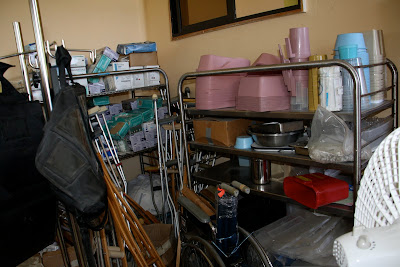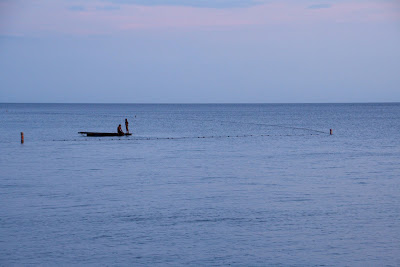Especially when it’s Friday when work is finished, and the
beach is a 15-minute walk down a mountain.
Since beach-destined paperbacks and my iPod’s indie rock
genre were re-routed to my bunk bed and absorbed most of today’s boredom
shockwaves, I’ll share a few things I’ve been saving up.
Last week, we drove a mother and her 8 mo. old daughter to
St. Marc for an X-ray. Tired bodies crushed together in the truck, cramped with
our mobile Mamba clinic supplies.
Haitians stuck out their thumbs like hitchhikers or waved at
us with both arms as we passed, asking for a ride in the empty truck bed. Younger
children jumped in as it bumped along, some naked and careless and not
bothering with any gestured formality.
The young mother breastfed her daughter and shielded her
baby’s eyes while the truck lurched up and down the mountainside. After working
the Mamba clinic for the past two weeks and seeing so many young mothers or
female caretakers detached from their children, I was struck by the tenderness
of the gesture. Cradling the tiny girl’s head under her breast, clucking softly
to the baby, and of course the willingness to cram herself in the truck
alongside strangers to drive to a far-off hospital, seemed almost beyond the
call of duty for the typical mother.
Affection is often treated like it's impractical.
My first week here, Elsie told me a “good” mother provides
enough food for her children to live without starving; that’s all that’s
required to meet that guideline. I refused to believe that can be true, at
least not entirely.
She told me a story about a young missionary woman who went
to the beach and saw a Haitian toddler alone. She played with the child while
the parents watched not far away. When it was time for the missionary to leave,
the parents emerged and, seeing the young woman absolutely adored the child,
put the baby back into her arms and asked her to “keep.” Shocked, the young
missionary refused.
However, the next morning, the parents arrived at Canaan
with the child dressed neatly in her best clothes, clean and perfumed, to ask
the missionary to, please, take their child. For real. To keep. The parents had
discussed it seriously all night and decided they wanted to give their baby to
the missionary. They did not love the girl, and knew she would be better off
with someone who did. Once again, the missionary refused – she couldn’t just
put a baby in her carry-on back to the states – but Elsie said it was a lesson
in Haitian parenting.
Detachment is a survival mechanism. Show someone else’s baby
love, she warned, and they might just try to give their child away.
But there are exceptions for everything.
Single mothers make up the bulk of Haitian family units from
my experience in Montrouis. Women of some relation raise the children, commonly
older daughters or grandmothers, while the mothers are at the market during the
day, bartering and selling. Fathers are absent from the picture, some working
their cattle under the banana trees, some in odd-jobs in Port-au-Prince, while
the kids grow up.
The women at Canaan hired to take care of the babies at the
nursery are my age. Early 20s. No experience with children. Yet they’re living
like many Haitian women that age— 24/7 single moms.
It’s been rare from my experience so far, but there are some
fathers actively raising and loving on their children. For example, every week,
this adorable Haitian dad proudly totes his all-pink bundle of a 5 mo. old
girl. The baby’s mother died shortly after giving birth of infection.
Malnourished and sick, she was enrolled in the milk program at CESANOJE – open
to infants under 6 months who do not qualify for the peanut-butter based Mamba.
This dad, however, took all responsibility of child rearing. The baby’s finally
alert and putting some chub on her little cheeks, only months ago hollowed with
starvation.
Most of the “orphaned” children at Canaan are actually just
motherless. Many have fathers or older siblings that live in Montrouis and the
surrounding towns. But without a mother, the family unit crumbles. Just this
week, a father asked us to take his little boy and presented us with his
mother’s death certificate.
Dead mothers make orphans. Dead fathers make hungrier
bellies.
Working at Canaan, I’ve noticed distinct gender roles. The
men are laborers, in charge of maintenance and construction around the
orphanage, clinic and school. The women do the cooking, the cleaning, and all
the laundry. None of the men here do their own laundry, not even the boys in
the orphanage – the girls inherit that chore. Ironically, the women at Canaan
hold the powerful leadership positions when it comes to leading incoming
missionary groups and negotiating donations with non-profit relief agencies.
Even the clothes here are gendered. Men wear pants and jeans,
while women wear dresses and skirts paired with Ts and the occasional tank top.
Some of the bolder 20-somethings wear tight Capri pants. I’ve never see shorts,
except on hairy white legs of missionary men and on young girls chasing through
slums of Port-au-Prince’s.
Just yesterday, Doctor Jean Robert and I were sipping our
black coffee after breakfast, when we received a call. Without a goodbye, he
shoved his dirty dishes in my direction and walked off, leaving me fuming. Was
he handing me his dirty dishes because I was a woman? Everyone took care of
their own dishes and did their own washing, and I pointed this out to the
doctor later that day. He seemed unruffled, and I decided to resign myself to
cultural norms. If I didn’t pick up his dirty dishes, one of the overworked
Haitian women would have to do it.
Doesn’t make it any easier to swallow without resentment.
The gender distinction is particularly interesting when
Caroline and I are on Mamba duties. Two white woman driving through town to
pick up food is met by laughing men, partly in surprise and more in rude
amusement, following us in a herd as we load up the 50 lb sacks of white Texas
rice and pinto beans. Women, in our festive skirts and poker faces, carrying
our heavy loads to the truck bed while they shake their heads and grin as if to
tell us, this ain’t no women’s work.
Cute Haitian Folklore: The Origin of Dimples
The Haitian doctor working at CESANOJE (nickname for
Canaan’s community clinic, Center de Santé Nouvelle Jerusalem), shared
with me some cute folklore: The story of dimples.
When Haitians talk about dimples, they also point to their
lower backs, where the spine curves into the buttocks.
To get dimples, a mother has to push her fingers hard into
her baby’s cheeks and lower back during those formative days. Then, voila!
Dimples. If someone doesn’t have dimples, their mother either didn’t take an
active role in the dimple making, or push hard enough.
Every time I see a Haitian with dimples, I can’t help but
smile and imagine a mother’s fingers prodding the cheerful indentions.



























